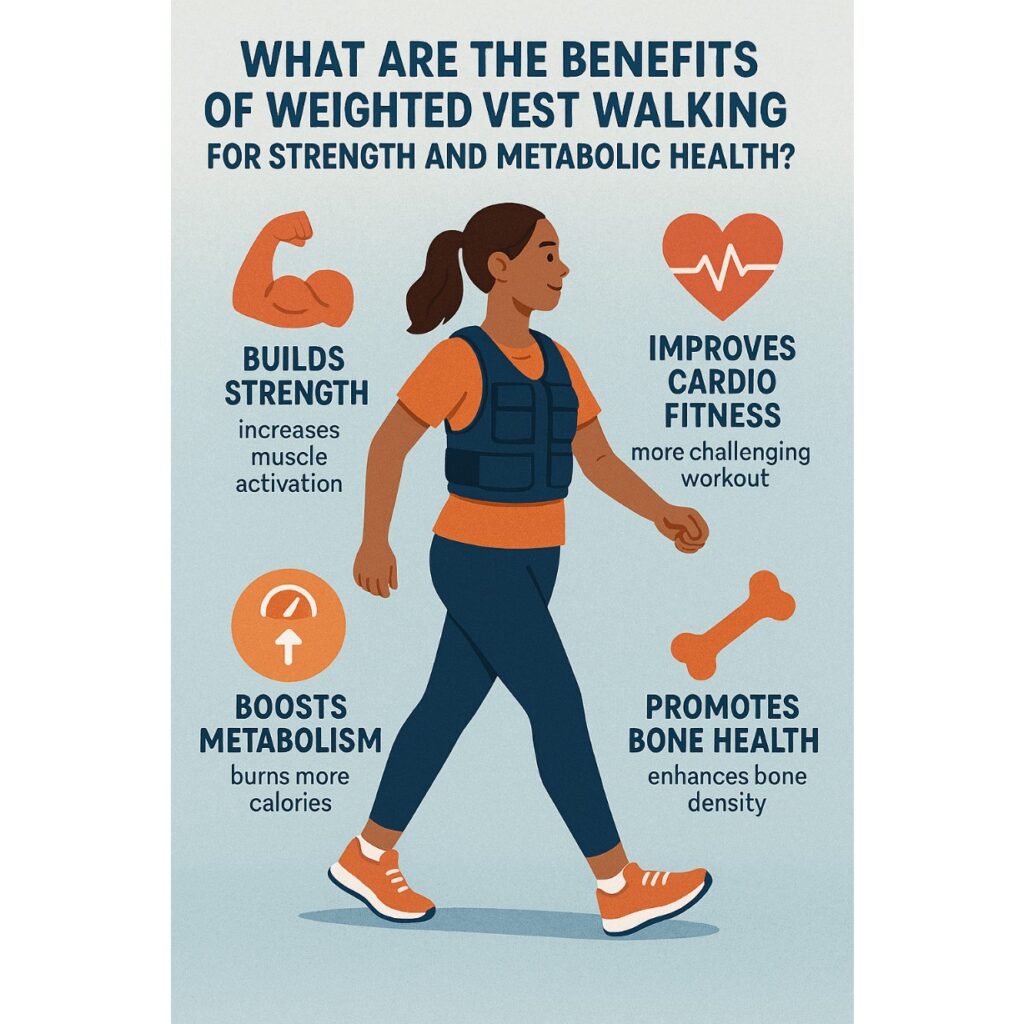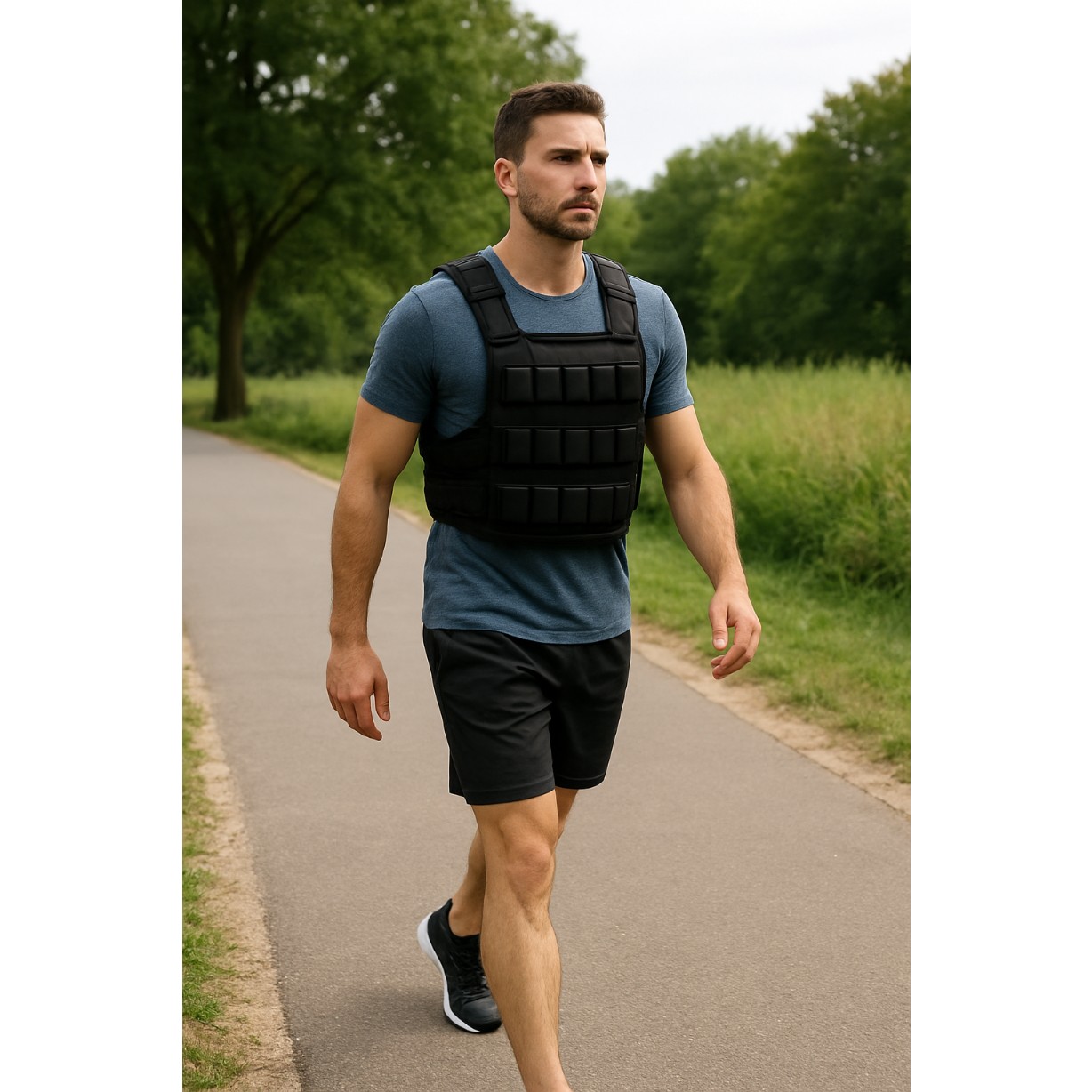Weighted vest walking has emerged as one of the most effective fitness strategies for individuals seeking to combine strength training and metabolic health benefits in a simple, accessible way. Unlike traditional workouts that require gym equipment, weighted vest workout routines leverage the body’s natural movements while adding resistance. This simple technique can elevate calorie burn with weighted vests, enhance cardio endurance, improve bone strength, and promote fat oxidation during resistance walking.

In this comprehensive guide, we explore the many advantages of incorporating weighted vest strength training into your fitness routine, while examining its impact on muscle engagement during walking, core activation with weighted vests, and overall functional strength exercises.
1. Strength and Muscle Building with Weighted Vest Walking
Weighted vest walking is not just about cardio; it’s a powerful tool for muscle engagement during walking and upper body toning with vests. Adding a weighted vest workout routine increases the workload on leg muscles, glutes, and the core activation with weighted vests, making even a short walk a full-body workout.
- Leg Strength Improvement: Walking with a weighted vest enhances leg strength improvement by forcing the muscles to work harder against resistance. This strengthens quadriceps, hamstrings, and calves.
- Upper Body Toning: While walking primarily targets the lower body, the added weight engages the shoulders, back, and arms, leading to upper body toning with vests.
- Core Activation: Proper posture and walking mechanics with added weight engage the abdominal muscles, resulting in core activation with weighted vests and improved posture correction with resistance.
- Functional Strength Exercises: Weighted vest walking counts as functional strength exercises, helping the body handle everyday movements more efficiently. This makes activities like climbing stairs, lifting groceries, or playing sports easier and safer.
Moreover, research indicates that bone density enhancement occurs naturally through weight-bearing exercises like weighted vest walking. Regular use can also contribute to posture correction with resistance, promoting better spinal alignment and reducing the risk of injury.
2. Boosting Metabolic Health and Fat Loss
One of the most compelling reasons to practice weighted vest walking is its profound effect on metabolic rate elevation and fat-burning workouts. By adding extra resistance, the body expends more energy, increasing overall calorie burn with weighted vests.
- Increased Metabolism: Incorporating resistance into walking can accelerate metabolism, which supports weight loss with added resistance and promotes fat oxidation during resistance walking.
- Enhanced Calorie Expenditure: Even low-intensity walking becomes a high-energy activity, leading to enhanced calorie expenditure throughout the day.
- Body Composition Improvement: Consistent weighted vest workouts improve lean muscle mass while reducing fat stores, contributing to body composition improvement.
- Zone 2 Cardio Benefits: When combined with moderate-paced walking, weighted vests can simulate Zone 2 cardio benefits, which optimize fat-burning while maintaining cardiovascular health.
This approach is especially effective for individuals seeking weight loss with added resistance without engaging in high-impact exercises that may stress joints. The gradual, consistent nature of fat oxidation during resistance walking ensures sustainable results and long-term metabolic health improvements.
3. Cardiovascular and Endurance Benefits
Weighted vest walking significantly boosts cardio endurance with weighted vests and heart rate elevation during walking. The additional load challenges the cardiovascular system, which improves aerobic capacity improvement and strengthens the heart.
- Walking Stamina Enhancement: Over time, individuals notice better walking stamina enhancement, enabling longer and more efficient walks without fatigue.
- Oxygen Consumption Increase: The body adapts to the added resistance by increasing oxygen uptake, supporting oxygen consumption increase and improving overall endurance.
- Blood Circulation Boost: Weighted vest walking promotes blood circulation boost, delivering oxygen and nutrients to muscles more effectively.
- Heart Health Through Resistance Walking: Regular sessions contribute to cardiovascular health benefits, reducing the risk of heart disease and improving overall wellness.
Endurance training with a weighted vest is both safe and effective, making walking performance optimization accessible to a wide range of fitness levels. Whether combined with traditional cardio or performed independently, the benefits of endurance training with resistance cannot be overstated.
4. Bone Health and Injury Prevention
Weighted vest walking is an excellent weight-bearing exercise benefits activity that promotes bone mineral density improvement and helps prevent conditions such as osteoporosis. The added resistance strengthens the musculoskeletal system, improving joint protection through resistance.
- Osteoporosis Prevention with Walking: Regular use of a weighted vest can reduce the risk of fractures by enhancing bone strength enhancement.
- Joint Stability and Lower Back Pain Relief: The gentle yet effective resistance supports knee joint stability and lower back pain relief by reinforcing muscles surrounding the joints.
- Post-Injury Rehabilitation: Weighted vest walking is often used in post-injury rehabilitation programs to rebuild strength safely while maintaining mobility.
- Musculoskeletal Health Support: Overall, the practice supports musculoskeletal health support, ensuring long-term joint and bone integrity.
This makes bone strength enhancement one of the most significant benefits of weighted vest walking, particularly for older adults or individuals recovering from injury.
5. Balance, Posture, and Mobility
A lesser-known advantage of weighted vest walking is its contribution to balance improvement with weighted vests, posture enhancement during walking, and stability training with resistance. These benefits enhance functional movement and reduce injury risk.
- Mobility Exercises with Added Weight: Weighted vest walking encourages mobility exercises with added weight, promoting joint flexibility and dynamic movement.
- Gait Correction Techniques: The added weight forces the body to maintain proper alignment, supporting gait correction techniques.
- Functional Movement Support: The exercise improves functional movement support, making everyday activities smoother and safer.
- Core Stability Exercises: Maintaining balance with additional resistance engages core muscles, resulting in better core stability exercises and overall coordination.
As a result, flexibility maintenance, coordination improvement, and dynamic movement training become natural byproducts of consistent weighted vest use, enhancing overall fitness levels.
6. Tips for Safe and Effective Weighted Vest Walking
While the benefits of weighted vest walking are significant, it is crucial to practice it safely:
- Start Light: Begin with a lightweight vest to allow the body to adapt gradually. This ensures proper muscle engagement during walking without strain.
- Maintain Proper Posture: Focus on core activation with weighted vests and upright posture to prevent injury and maximize upper body toning with vests.
- Increase Gradually: Gradually add weight as leg strength improvement and cardio endurance with weighted vests improve.
- Combine with a Balanced Routine: Pair with stretching, mobility, and other functional strength exercises to maximize benefits.
- Monitor Heart Rate: For Zone 2 cardio benefits, track heart rate to maintain optimal fat-burning and endurance improvement.
By following these guidelines, individuals can enjoy the comprehensive advantages of weighted vest walking, from fat oxidation during resistance walking to bone density enhancement and dynamic movement training.
Conclusion
Weighted vest walking is a versatile, effective, and accessible form of exercise that offers a wealth of benefits for strength and metabolic health. From enhancing muscle engagement during walking and core activation with weighted vests to supporting fat-burning workouts, cardio endurance, and bone strength enhancement, the advantages are far-reaching.
Additionally, it improves posture correction with resistance, joint protection through resistance, and dynamic movement training, making it suitable for individuals of all ages and fitness levels. With the right approach, weighted vest workout routines can provide lasting results in both body composition improvement and overall functional fitness.
Integrating weighted vest walking into a regular routine is a simple yet powerful way to maximize calorie burn with weighted vests, enhance heart health through resistance walking, and achieve a stronger, healthier body while boosting metabolic rate elevation.
